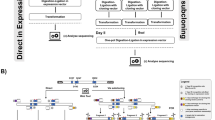Abstract
Random mutagenesis of a cloned gene remains a central method to understand many aspects of the gene products' function and structure. Having the ability to introduce a limited number of changes within a gene in a controlled fashion allows one to evaluate single changes and study the effect these variants have on the gene of interest. The in vivo random mutagenesis strategy described in this article, using anE. coli host, is a convenient method to introduce a limited number of mutations in a controlled manner.
Similar content being viewed by others
References
Miller, J. H. (1992)A Short Course in Bacterial Genetics, Cold Spring Harbor Laboratory Press, Cold Spring Harbor, NY.
Greener, A. and Callahan, M. (1994) XL1-RED: a high efficient random mutagenesis strain.Strategies 7, 32–34.
Radman, M., Wagner, R. E., Glickman, B. W., and Meselson, M. (1980) DNA methylation, mismatch correction, and genetic stability, inProgress in Environmental Mutagenesis (Alevic, M., ed.), Elsevier, Amsterdam, pp. 121–130.
Cox, E. C. (1976) Bacterial mutator genes and the control of spontaneous mutation.Ann. Rev. Genet. 10, 135–156.
Scheuermann, R., Tam, S., Burgers, P. M. J., Lu, C., and Echols, H. (1983) Identification of the e-subunit ofEscherichia coli DNA polymerase III holoenzyme as thednaQ gene product: a fidelity subunit for DNA replication.Proc. Natl. Acad. Sci. USA 80, 7085–7089.
Hanahan, D. (1983) Studies on transformation of Escherichia coli with plasmids.J. Mol. Biol. 166, 557–580.
Tomizawa, J. and Som, T. (1984) Control of ColE1 plasmid replication: enhancement of binding of RNA 1 to the primer transcript by the rom protein.Cell 38, 871–878.
Lacatena, R. M., Banner, D. W., Castagnoli, L., and Cesareni, G. (1984) Control of initiation of pMB1 replication: purified rop protein and RNA 1 affect primer formationin vitro.Cell 37, 1009–1014.
Uhlin, B. E., Molin, S., Gustafsson, P., and Nordstrom, K. (1979) Plasmids with temperature dependent copy numbers for amplification of cloned genes and their products.Gene 6, 91–103.
Harley, C. B. and Reynolds, R. P. (1987) Analysis ofE. coli promotor sequences.Nucleic Acids Res. 15, 2343–2361.
Author information
Authors and Affiliations
Corresponding author
Rights and permissions
About this article
Cite this article
Greener, A., Callahan, M. & Jerpseth, B. An efficient random mutagenesis technique using anE.coli mutator strain. Mol Biotechnol 7, 189–195 (1997). https://doi.org/10.1007/BF02761755
Issue Date:
DOI: https://doi.org/10.1007/BF02761755




